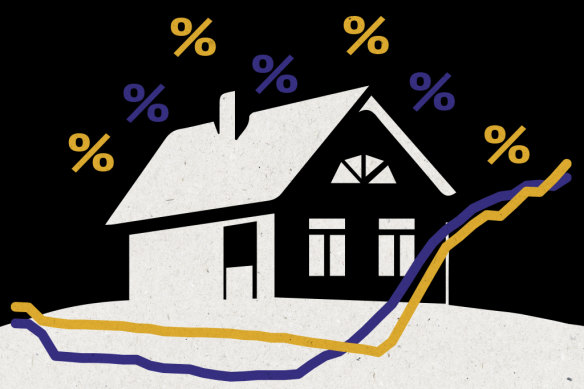Opinion
The ‘brace position’ that could help some homeowners’ budgets
Nicole Pedersen-McKinnon
Money contributorI was surprised when a recent report from the Australian Securities and Investments Commission suggested it was difficult to get a home loan holiday, especially when fresh talk of rate rises may mean you could really do with one.
It said lenders were essentially giving borrowers the repayment-relief runaround: making them prove a lot, setting the hurdles to get help hugely high, and even making it hard to find the right department to apply.

Aussie borrowers now know to talk to their lender before they get into serous money trouble, and that’s a good thing.Credit: Marija Ercegovac
But take heart: I’ve heard – from experiences shared with me by hundreds of readers – differently.
I’ve even personally seen differently, coaching people as I have through the conversation to initially ask for home loan hardship. I’ve witnessed them getting through fast to clearly large, well-resourced financial hardship departments.
Data given to me this week bears this out. One of Australia’s three credit bureaus, Experian, tells me successful applications for financial hardship are up, with around 0.3 per cent of mortgage holder credit files now showing that indication.
Experian’s director of client advisory for credit services, Charlotte Rankin, tells me these numbers might seem small, “but they tell a big story”.
And that’s about Australian borrowers now knowing to talk to their lender before they get into serous money trouble. As I write and say often: today, confessions get significant concessions.
That recent ASIC review of hardship applications revealed there have been more than 430,000 applications from over 170,000 customers since 2022. Almost 40 per cent relate to home loans; 80 per cent owner occupied.
So, what does hardship help look like today? We are talking full home loan holidays of up to three months, half payments for six months, or a switch to interest-only. Your interest rate might even be reduced, or your loan term extended to bring repayments down permanently.
And borrowers being open and honest about times being too tight has led to a plateau in mortgage arrears, says Rankins, after a lift on the most recent rate hike in November last year.
It’s a far better strategy because missing a payment pushes down your credit score – after just 14 days, a black repayment mark will stay on your file for two years.
A hardship deal does not impact your score – provided you make the renegotiated payment, you are marked as on time and up-to-date. Recent changes mean there’s just a hardship repayment label that disappears after a year.
Rankins says: “I think it’s created more transparency around financial hardship. These programs are in place to support people in financial stress.” But particular groups of borrowers are more at risk of falling behind if they don’t put up their hand for help.
Of borrowers who bought with less than a 20 per cent deposit, since June 2022 there’s been a more than 80 per cent increase in mortgage arrears. This compares with around a 50 per cent increase for those less than 80 per cent leveraged.
It’s a relief that Australians stretched to the mortgage max are asking for – and receiving – hardship help.
And those who took out a home loan after 2019 are four times more likely to miss repayments compared to those who borrowed before 2015.
Unfortunately, age is a factor too: Mortgage holders aged 18 to 24 have been notably affected by cost-of-living pressures, showing a rise in mortgage arrears from the lowest starting point of 0.8 per cent to a peak of 1.4 per cent.
The other side of the financial-stress story is data on our non-mortgage loans. Personal loans and auto loans are notably experiencing delinquencies, back to pre-COVID levels of 0.8 per cent for personal loans and 0.5 per cent for automotive loans.
People aren’t generally applying for hardship here, though (they should) – just not paying.
And that, together with the higher home loan hardship indications and stabilising mortgage arrears, all speaks of our instinct during money dramas: protect our home over all else.
“I used to work in collections, and we used to see that people would prioritise their mortgage … so they would miss payments on personal loans,” Rankin says.
Interestingly, too, Experian recorded an increase in credit demand across personal loans over the 2023-24 holiday period.
And it’s at a time lenders are – perhaps due to increased repayment risk – withdrawing from this market. Datahouse Mozo says NRMA, Macquarie and Coles have recently stopped offering car loans; other lenders are raising rates.
Australians are apparently turning to delay-pay mechanisms to relieve purse-string pressures, too. Rankins says: “The increase in buy-now-pay-later services and personal loans alongside a reduction in mortgage inquiries may indicate borrowers are facing financial difficulties.”
So, it is a great relief that people stretched to the mortgage max are asking for – and receiving – hardship help.
Nicole Pedersen-McKinnon is the author of How to Get Mortgage-Free Like Me, available at www.nicolessmartmoney.com. Follow Nicole on Facebook, Twitter or Instagram.
- Advice given in this article is general in nature and is not intended to influence readers’ decisions about investing or financial products. They should always seek their own professional advice that takes into account their own personal circumstances before making any financial decisions.
Expert tips on how to save, invest and make the most of your money delivered to your inbox every Sunday. Sign up for our Real Money newsletter.